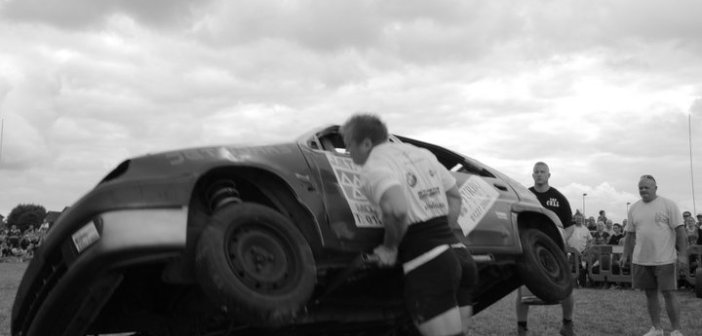The following article is by Ben Kelsey, current holder of World’s Strongest Man under 105kg and Britain’s Natural Strongest Man (open weight) titles. Ben is also a personal trainer in Oxford, England. His website can be found here.
So you call yourself a strongman? Fair enough, you spend endless hours watching video clips of people lifting weird and wonderful objects, your food and supplement bill comes to hundreds of pounds a month, you may even compete three or four times a year… So why don’t you train like one?
Strongman isn’t Olympic lifting, it’s not powerlifting and it certainly isn’t bodybuilding. People who follow a powerlifting routine coupled with the odd event session are selling themselves short. A long jumper doesn’t just practise their run up, what sort of rugby player doesn’t bother to practise tackling?
Can you see what I’m getting at? Strongman, unlike powerlifting, marathon running and archery requires talent in many different areas of fitness.
Don’t get me wrong, being strong comes first. It doesn’t matter what else you are, if you’re not strong little else matters. But just being gym strong isn’t enough to be seriously competitive at strongman.
Let’s look at some of the components of fitness in relation to strongman:
- Strength – I don’t think this one requires much in the way of explanation
- Speed – Of much smaller significance, but foot speed is very important on events like yoke and farmers. It also comes into play with loading where events can be won or lost by fractions of a second.
- Endurance – Anaerobic endurance plays a big part in strongman. All repping events, medleys and many others last in excess of 60 seconds; it doesn’t matter how strong you are if you can only perform for 30 seconds. Additionally, endurance comes into play when competitions move at a fast pace – still feeling knackered from the previous event? Struggling to lift that 100KG atlas stone because it’s the 7th event?
- Flexibility – Really? I hear you say! I could probably count the number of strongmen who regularly stretch on one hand. Should they? Should you? Improved range of movement is a good thing, it might not directly help with many strongman events but it certainly won’t do any harm. However it can and does drastically reduce your chance of picking up injuries and for that alone its worth doing.
- Power – A combination of two things we have previously mentioned: speed and strength. Surely this one is obvious, but I have a strong suspicion that its neglected by many.
- Agility – Similar in many ways to flexibility, it really isn’t going to make or break you as a strongman, but it helps. Seconds can be shaved off your time in a medley; time between stones can be reduced. These things are small, some would even say insignificant but they add up and they can be what make the difference between victory and failure.
So, we’ve established that the demands of strongman go beyond just strength. Can you now see why I question whether just lifting big weights in the gym is sufficient?
Phil Phister posted this video over 5 years ago, I watched it before I’d ever lifted a log or seen an atlas stone and its stuck with me ever since. To me this is how you “train like a strongman”:
I’m not suggesting that you should swap deadlift for some sprint training and stop squatting in favour of a hamstring stretch but can you seriously expect to be good at something if you don’t train it? Training everything requires more time and effort that you or I are able to give (unless you’re a full time strongman) but try doing 15 minutes speed work on your rest day from the gym. Think about adding in 10 minutes of flexibility after each training session. I know none of you are actually going to do cardio, but you should!
Training doesn’t just mean lifting heavy weights, be honest with yourself if you have a weakness confront it face on, don’t shy away from what you think might be hard work.
Agree with Ben? Post your comments below.



